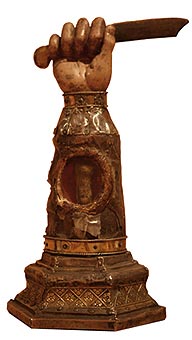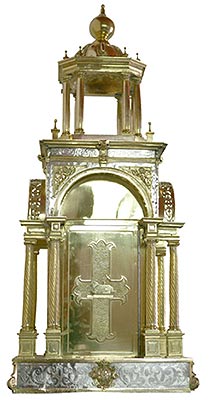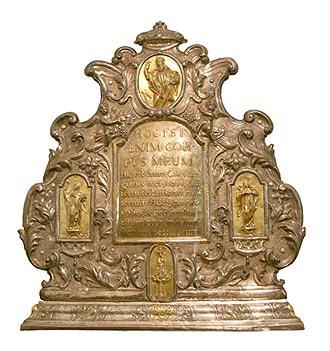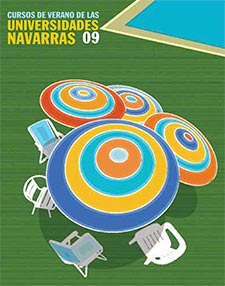BRINGING THE HERITAGE CLOSER. ESTELLA, ART AND THE ROAD
27 August 2009
The Sumptuary Arts in Estella: from the Age average to the 19th century
D. Ignacio Miguéliz Valcarlos. Chair of Heritage and Navarrese Art.
The art of silverware in Estella is an important chapter in the artistic panorama of the city. A large and rich collection of works has reached our days, covering pieces from the age of average to the 19th century. These works come from various workshops, including not only Navarrese workshops, but also from the Iberian Peninsula and the Americas.
It is worth mentioning the privilege granted in 1414 by Charles III to the Estellan regiment to mark the silver with the punch of their choice, the city choosing the Latin name in Gothic script surmounted by a six-pointed star, ESTELA/* without the obligation to stamp the author's mark. This punch will survive until the beginning of the 17th century, when it will be replaced by the second variant of the city's mark, a star, in which the issue of points will vary. This punch will remain in force until the middle of the 18th century when it will be replaced by the third variant, the name of the city arranged in two lines ES/TELLA.
However, few are the pieces punched with marks of Estella that have survived to the present day, as is the case with the punches of silversmiths who settled in the city. It was not until the beginning of the 17th century that we find marks of silversmiths, since the privilege of Charles III did not say anything about the need for the authors to mark the pieces they worked.
As for the works preserved in the temples of the city, it is worth mentioning not only pieces from the workshops of Estella, but also from other workshops in Navarre, as well as from Spain and Latin America. Thus we find pieces from Estella and Pamplona, from Zaragoza, Barcelona or Cordoba, and from Peru or Mexico.
Almost all these works are reduced to the typologies most used in the Christian liturgy, especially with regard to the shaft pieces, such as chalices, of which a large number are preserved group, thanks to which an evolutionary study of the different styles over the centuries could be made. Within this panorama, of special importance is the group of reliquary arms, most of them of Gothic style, from both the 15th and 16th centuries, the most modern being dated 1612. It can be said that in Estella almost seventy percent of the works of this subject that have reached our days in Navarre are preserved, which shows how popular this typology was among the silversmiths of Estella. Of great importance is also the reliquary of the Holy Innocents, the only reliquary bust of medieval times preserved in Navarre.

Reliquary arm. Parish of San Miguel. Estella
Also of special importance is the monstrance of the temple of the Benedictine convent, today converted into a tabernacle, the only piece of this format preserved in Navarre. Or one of the sacras of this convent, with marks of the silversmith La Estrada and Zaragoza, with an interesting iconography related to the Benedictine order. Also in this same monastery interesting pieces of civil character are conserved, like the beautiful set of azafates.

Monstrance. Convent of the Benedictine Sisters of Estella.
And of great richness are the works from Hispanic-American workshops, all of them carved in the centuries of the baroque, of great exuberance, like the pieces of filigree or the ciborium of the convent of Clarisas, being of interest also two tortoiseshell chests with silverware applications, of civil origin and used in the temples as custody of the Blessed Sacrament.
Finally, we cannot overlook the theft committed in 1979 in the church of San Pedro, in which, along with a crosier and some Limoges cruets, the latter recovered in 1992, as well as other works, the reliquary with the relic of the scapula of St. Andrew, patron saint of the city, disappeared.

Sacra of the convent of the Benedictine nuns of Estella
PROGRAM
TUESDAY, AUGUST 25
The splendor of Estella in the Renaissance. Art and Artists
Ms. María Concepción García Gainza. Chair of Navarrese Heritage and Art.
Image of God, image of man: the façade of San Miguel de Estella
Mr. Javier Martínez de Aguirre Aldaz. Complutense University of Madrid
San Pedro de la Rúa: styles and interstyles in a medieval building.
D. Carlos J. Martínez Álava. I.E.S. "Pedro de Ursua" of Pamplona
WEDNESDAY, AUGUST 26TH
Following in the footsteps of the Gothic in Estella: Santo Sepulcro and Santo Domingo
Ms. Santiaga Hidalgo Sánchez. Chair of Navarrese Heritage and Art.
Estella's movable heritage
Ms. Mercedes Jover Hernando. Chair of Navarrese Heritage and Art.
A city born for the Camino. visit guided tour of the city of Estella
D. Román Felones Morrás. Full Professor of Geography and History of the I.E.S. Tierra Estella.
THURSDAY, AUGUST 27TH
Architecture and Humanism in Estella in the 16th century.
Mrs. María Josefa Tarifa Castilla. Chair of Navarrese Heritage and Art.
Traces of the Baroque in Estella
Ms. Pilar Andueza Unanua. Chair of Navarrese Art and Heritage.
The sumptuary arts in Estella: from the Age average to the 19th century.
D. Ignacio Miguéliz Valcarlos. Chair of Navarrese Heritage and Art.
FRIDAY, AUGUST 28TH
Images of a conflict. Estella and the last Carlist War
D. Ignacio Jesús Urricelqui Pacho. Chair of Navarrese Heritage and Art.
reportIdentity and image of Estella in the plastic arts of the 19th and 20th centuries.
Mr. José Javier Azanza López. Chair of Navarrese Heritage and Art.
Museum and city. Gustavo de Maeztu and Estella
D. Gregorio Díaz Ereño. Director of the Jorge Oteiza Museum.
Closing

